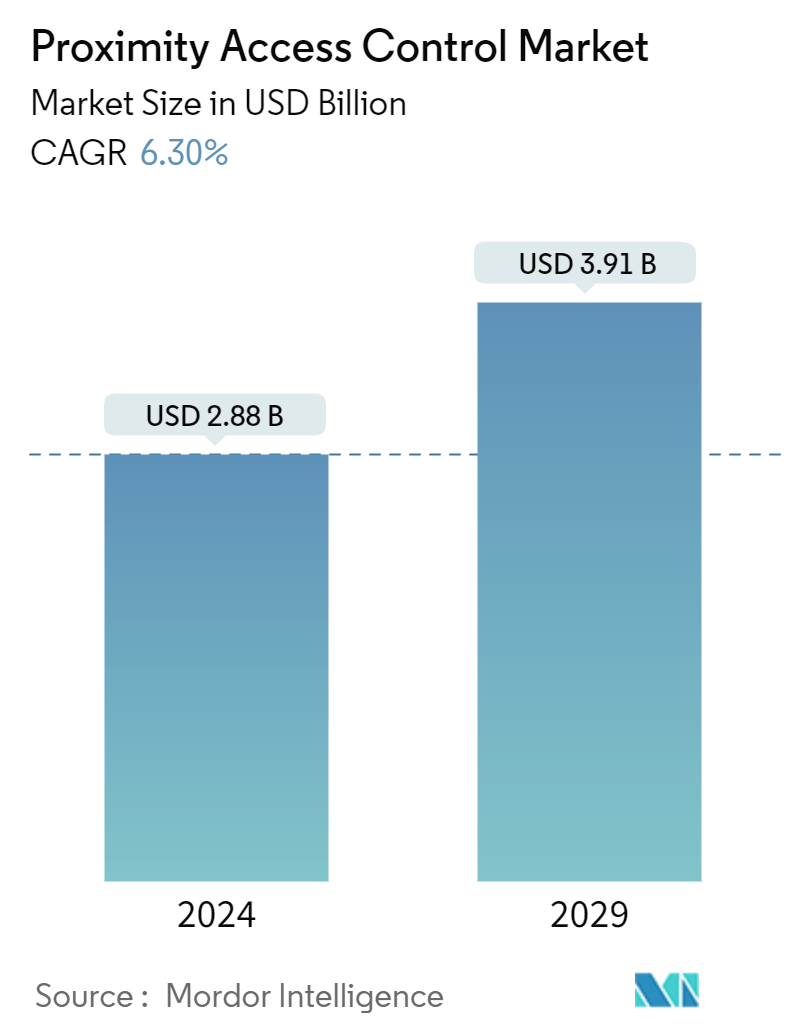Market Size of Proximity Access Control Industry

| Study Period | 2019 - 2029 |
| Market Size (2024) | USD 2.88 Billion |
| Market Size (2029) | USD 3.91 Billion |
| CAGR (2024 - 2029) | 6.30 % |
| Fastest Growing Market | Asia Pacific |
| Largest Market | North America |
| Market Concentration | Low |
Major Players
*Disclaimer: Major Players sorted in no particular order |
Proximity Access Control Market Analysis
The Proximity Access Control Market size is estimated at USD 2.88 billion in 2024, and is expected to reach USD 3.91 billion by 2029, growing at a CAGR of 6.30% during the forecast period (2024-2029).
• Proximity access control systems eliminated the requirement of physical keys, allowing for smooth entry into buildings or areas. Additionally, these systems provide enhanced security through encrypted communication and the ability to revoke access in case of a lost or stolen card. The increasing adoption of cloud access control systems offers high potential. These cloud-based systems provide scalability, adaptability, and remote management, enabling enterprises to manage access across multiple locations more easily. The widespread fingerprint recognition technology drives the growth of the proximity access control market.
• The use of proximity access control systems provides a high level of security compared to conventional methods, thus decreasing the likelihood of unauthorized access and security breaches. There is a rising demand for access control systems to be integrated with cutting-edge technologies such as AI and Machine Learning (ML).
• Access control systems can identify anomalies, analyze trends, and improve overall security by continuously learning and responding to new threats using AI and ML algorithms. Utilizing biometrics in access technologies will open up new possibilities for using only fingerprints or facial features. Utilizing biometric identifiers as an additional authentication factor (for example, biometric scans for physical identity verification) can assist organizations in eliminating unauthorized access and fraudulent algorithms.
• For instance, in March 2023, Vertiv announced the introduction of its Vertiv Intelligent Fingertrack Access Control System ((iFACS), a next-generation Data Center access control solution for rack enclosures in India. This IP-based Access Control Solution is intended to physically protect the racks containing mission-critical machinery, resources, and enterprise-level data. Vertiv's Intelligent Fingerspace Access Control System is a lock controller designed to protect the front and rear doors of Rack Enclosures. It has been developed with the most up-to-date biometrics and identity authentication technologies.
• The adoption of digital wallets is surging the rate of mobile ID adoption while also broadening the scope of use cases beyond payment transactions to include employee identification cards, driver's licenses, national identification cards, and passports.
• Major players such as Google, Apple, and Amazon are introducing digital wallets that are becoming increasingly popular. The capabilities of these wallets are expanding to include the ability to add keys, employee identification cards, student identification cards, and more directly to the wallet application. A prime example is Silverstein Properties in New York City, which provides employees with Apple Wallet access to secure contactless entry to their office buildings.
• The collection of access data has raised several privacy and data protection concerns, particularly in regions with stringent privacy regulations, thus impeding market development. Furthermore, macroeconomic factors such as government regulations on the import and export of the electronics market and the disruption in global supply chain operation have affected the market growth.
• Furthermore, integrating proximity access control systems into the existing infrastructure may be laborious and costly, thus discouraging the adoption. In addition, in some regions, companies may need to be aware of the advantages associated with proximity access control, resulting in a shortage of demand.
Proximity Access Control Industry Segmentation
The study tracks the revenue accrued through the sale of proximity access control software and hardware by various players in the global market. The study also tracks the key market parameters, underlying growth influencers, and major vendors operating in the industry, which supports the market estimations and growth rates over the forecast period. The study further analyses the overall impact of COVID-19 aftereffects and other macroeconomic factors on the market. The report’s scope encompasses market sizing and forecasts for the various market segments.
The proximity access control market is segmented by solution (Hardware and Software), by type (card readers, biometric scanners, proximity readers, alarms, metal detectors, door controllers, and wireless locks), by end-user industry (government services, banking and financial services, IT and telecommunications, transportation and logistics, retail, healthcare, residential, and others), and by geography (North America, Europe, Asia Pacific, and Rest of the World). The report offers market forecasts and size in value (USD) for all the above segments.
| By Solution | |
| Hardware | |
| Software |
| By Type | |
| Card Readers | |
| Biometric Scanners | |
| Proximity Readers | |
| Alarms | |
| Metal Detectors | |
| Door Controllers | |
| Wireless Locks |
| By End-user Industry | |
| Government Services | |
| Banking and Financial Services | |
| IT and Telecommunications | |
| Transportation and Logistics | |
| Retail | |
| Healthcare | |
| Residential | |
| Others |
| By Geography *** | |||||
| |||||
| |||||
| |||||
| Australia and New Zealand | |||||
| Latin America | |||||
| Middle East and Africa |
Proximity Access Control Market Size Summary
The proximity access control market is experiencing significant growth, driven by the increasing need for enhanced security and the adoption of advanced technologies. These systems, which eliminate the need for physical keys, offer improved security through encrypted communication and the ability to revoke access if a card is lost or stolen. The integration of cloud-based solutions provides scalability and remote management capabilities, making it easier for enterprises to manage access across multiple locations. The market is further propelled by the widespread adoption of fingerprint recognition technology and the integration of artificial intelligence and machine learning, which enhance security by identifying anomalies and analyzing trends. Biometric scanners, such as facial and fingerprint recognition, are becoming more prevalent, offering a high level of security by relying on unique psychological or behavioral traits.
The market is characterized by the introduction of innovative products and solutions by major players, aiming to expand their market presence through strategic partnerships and technological advancements. Companies like Johnson Controls, SALTO Systems, and ADT are actively developing and deploying new access control systems that incorporate biometric and digital wallet technologies. The rise of mobile ID adoption, facilitated by digital wallets from tech giants like Google, Apple, and Amazon, is broadening the scope of use cases for proximity access control systems. However, the market faces challenges such as privacy concerns, high integration costs, and the need for awareness in certain regions. Despite these challenges, the demand for contactless and smart lock solutions is growing, driven by the need for convenience, security, and compliance with health and safety regulations.
Proximity Access Control Market Size - Table of Contents
-
1. MARKET INSIGHTS
-
1.1 Market Overview
-
1.2 Industry Attractiveness - Porter's Five Forces Analysis
-
1.2.1 Bargaining Power of Suppliers
-
1.2.2 Bargaining Power of Consumers
-
1.2.3 Threat of New Entrants
-
1.2.4 Threat of Substitutes
-
1.2.5 Intensity of Competitive Rivalry
-
-
1.3 Impact of COVID-19 Aftereffects and Other Macroeconomic Factors on the Market
-
-
2. MARKET SEGMENTATION
-
2.1 By Solution
-
2.1.1 Hardware
-
2.1.2 Software
-
-
2.2 By Type
-
2.2.1 Card Readers
-
2.2.2 Biometric Scanners
-
2.2.3 Proximity Readers
-
2.2.4 Alarms
-
2.2.5 Metal Detectors
-
2.2.6 Door Controllers
-
2.2.7 Wireless Locks
-
-
2.3 By End-user Industry
-
2.3.1 Government Services
-
2.3.2 Banking and Financial Services
-
2.3.3 IT and Telecommunications
-
2.3.4 Transportation and Logistics
-
2.3.5 Retail
-
2.3.6 Healthcare
-
2.3.7 Residential
-
2.3.8 Others
-
-
2.4 By Geography ***
-
2.4.1 North America
-
2.4.1.1 United States
-
2.4.1.2 Canada
-
-
2.4.2 Europe
-
2.4.2.1 United Kingdom
-
2.4.2.2 Germany
-
2.4.2.3 France
-
-
2.4.3 Asia
-
2.4.3.1 China
-
2.4.3.2 Japan
-
2.4.3.3 India
-
-
2.4.4 Australia and New Zealand
-
2.4.5 Latin America
-
2.4.6 Middle East and Africa
-
-
Proximity Access Control Market Size FAQs
How big is the Proximity Access Control Market?
The Proximity Access Control Market size is expected to reach USD 2.88 billion in 2024 and grow at a CAGR of 6.30% to reach USD 3.91 billion by 2029.
What is the current Proximity Access Control Market size?
In 2024, the Proximity Access Control Market size is expected to reach USD 2.88 billion.

